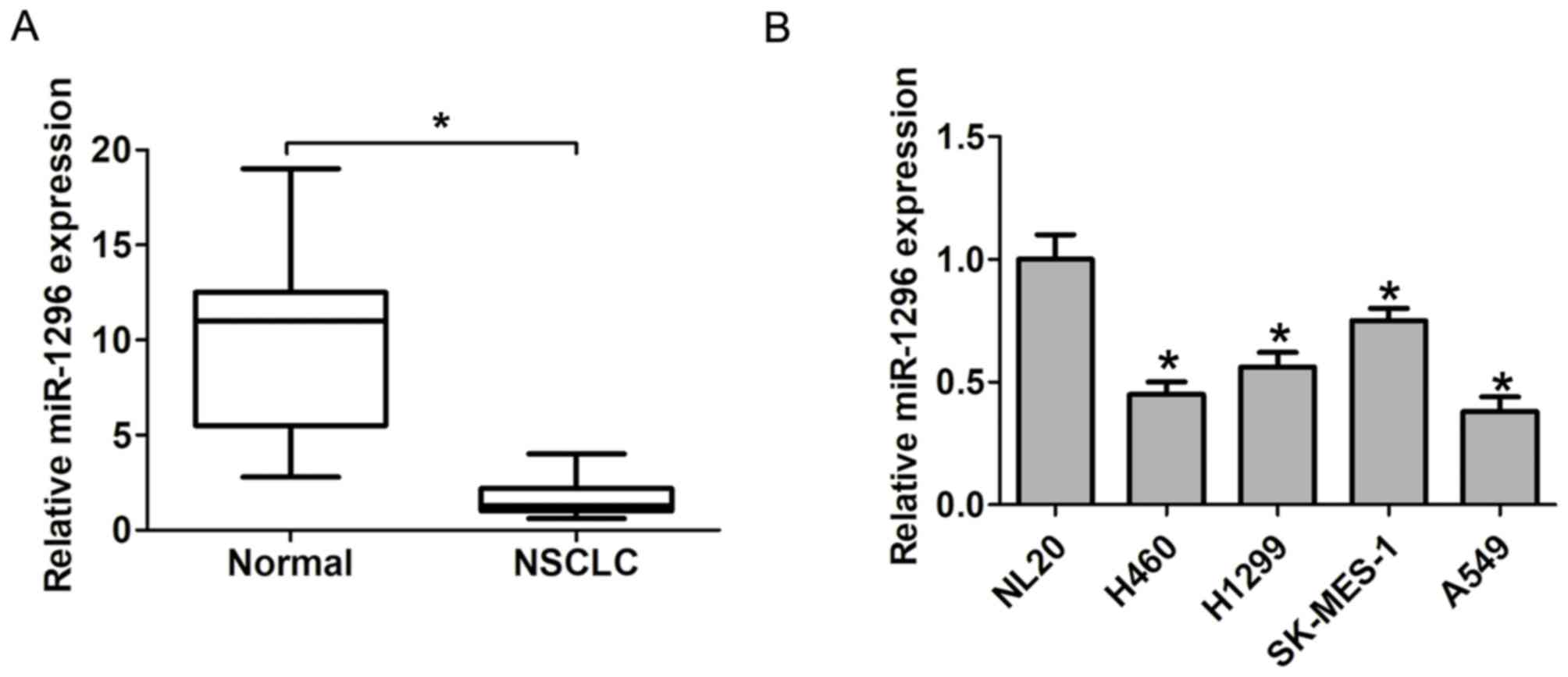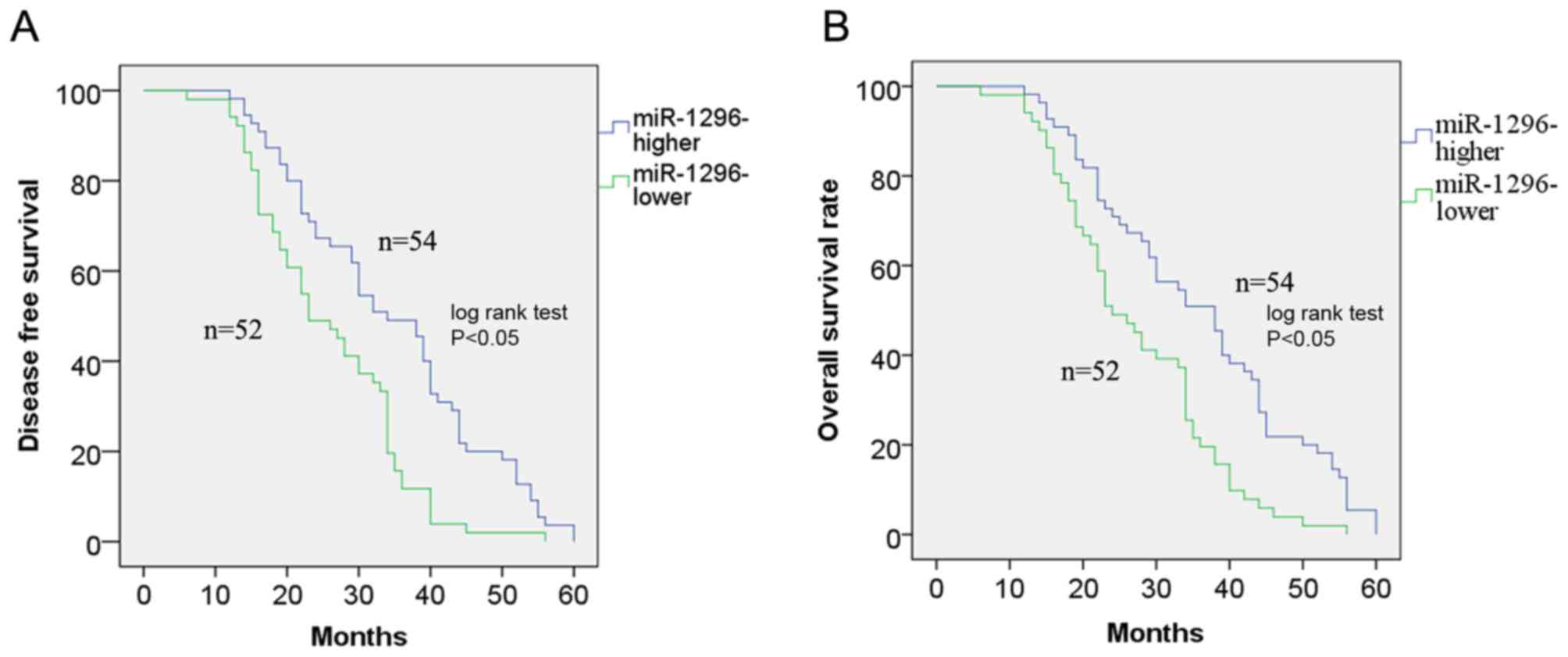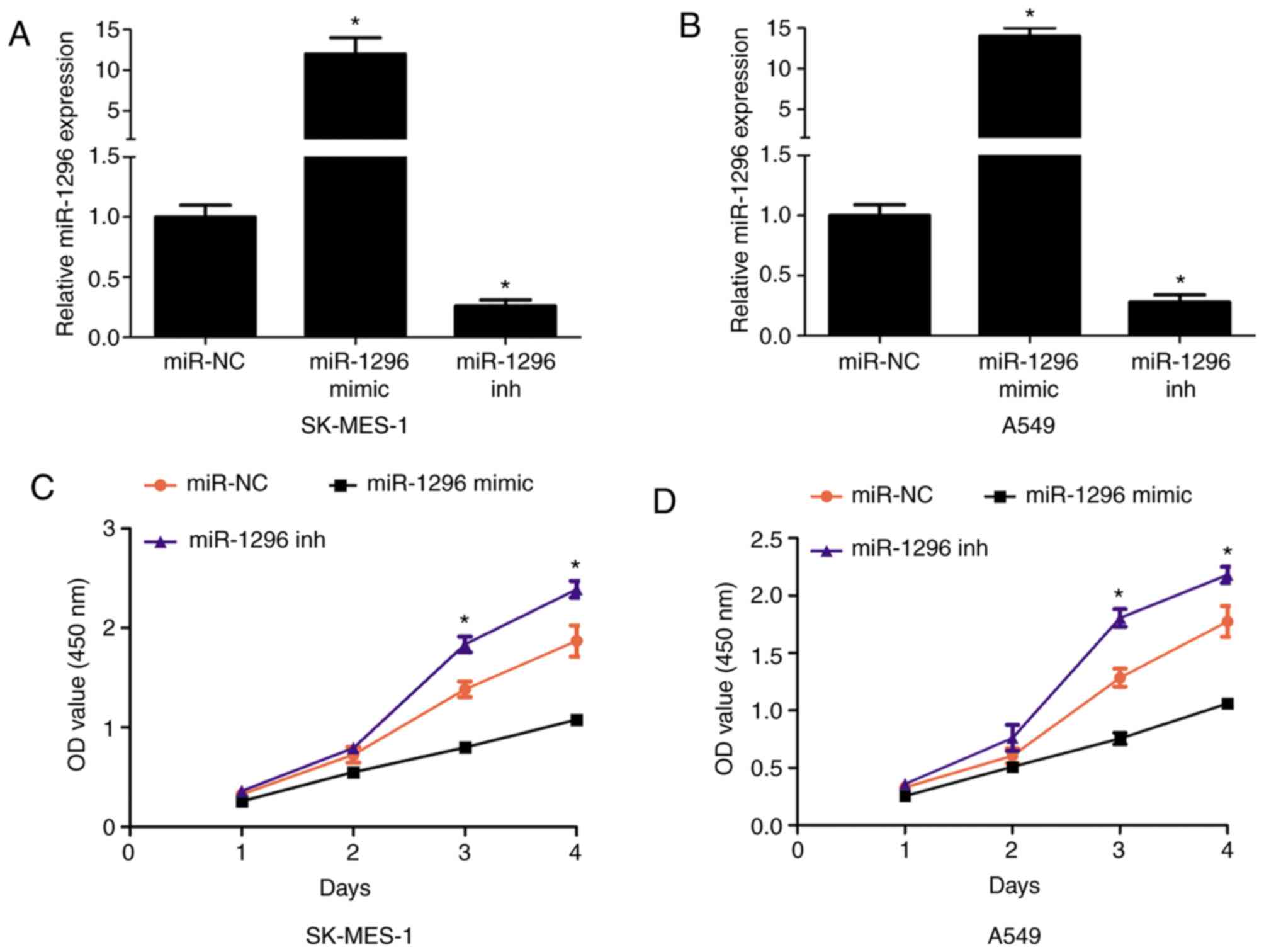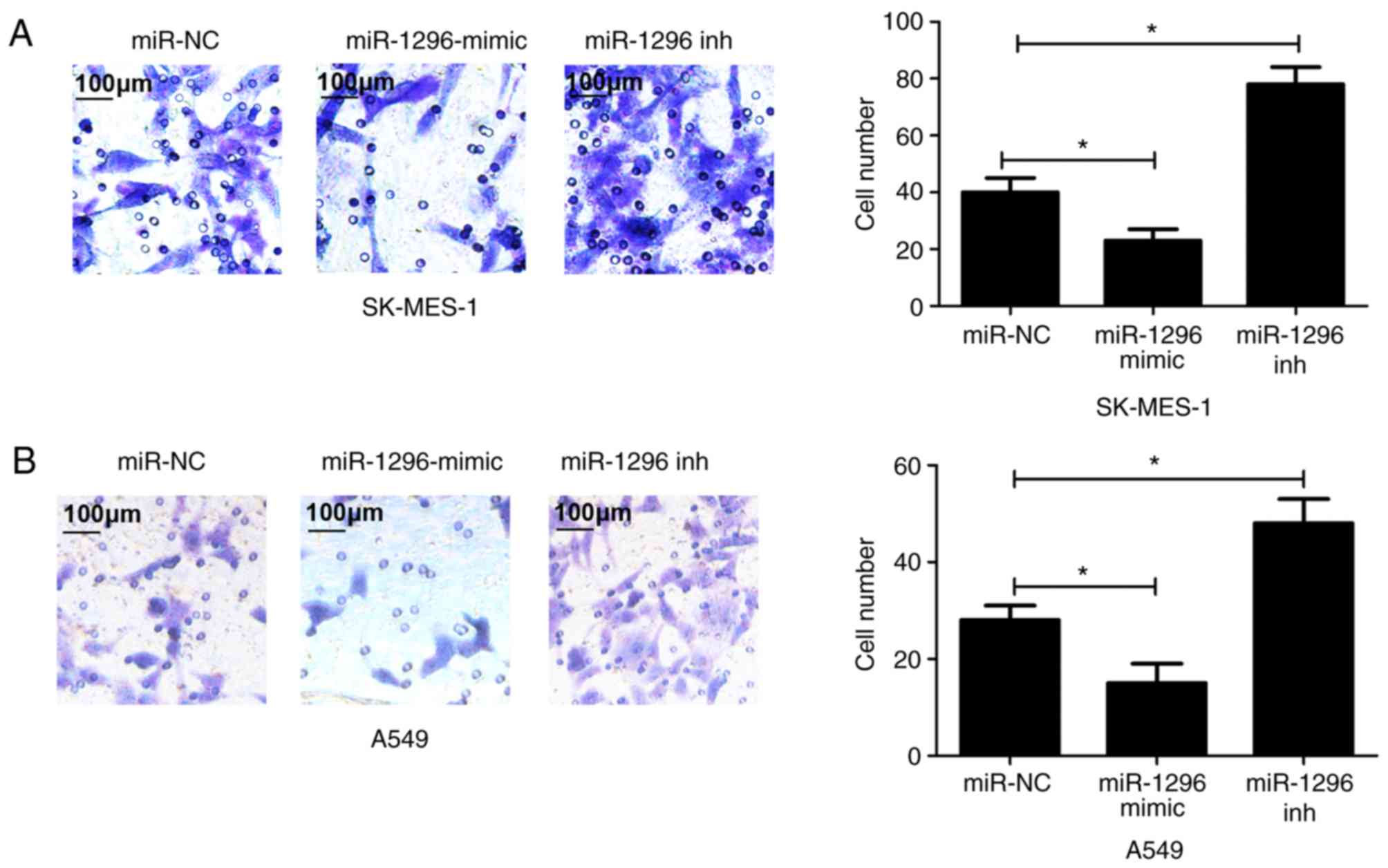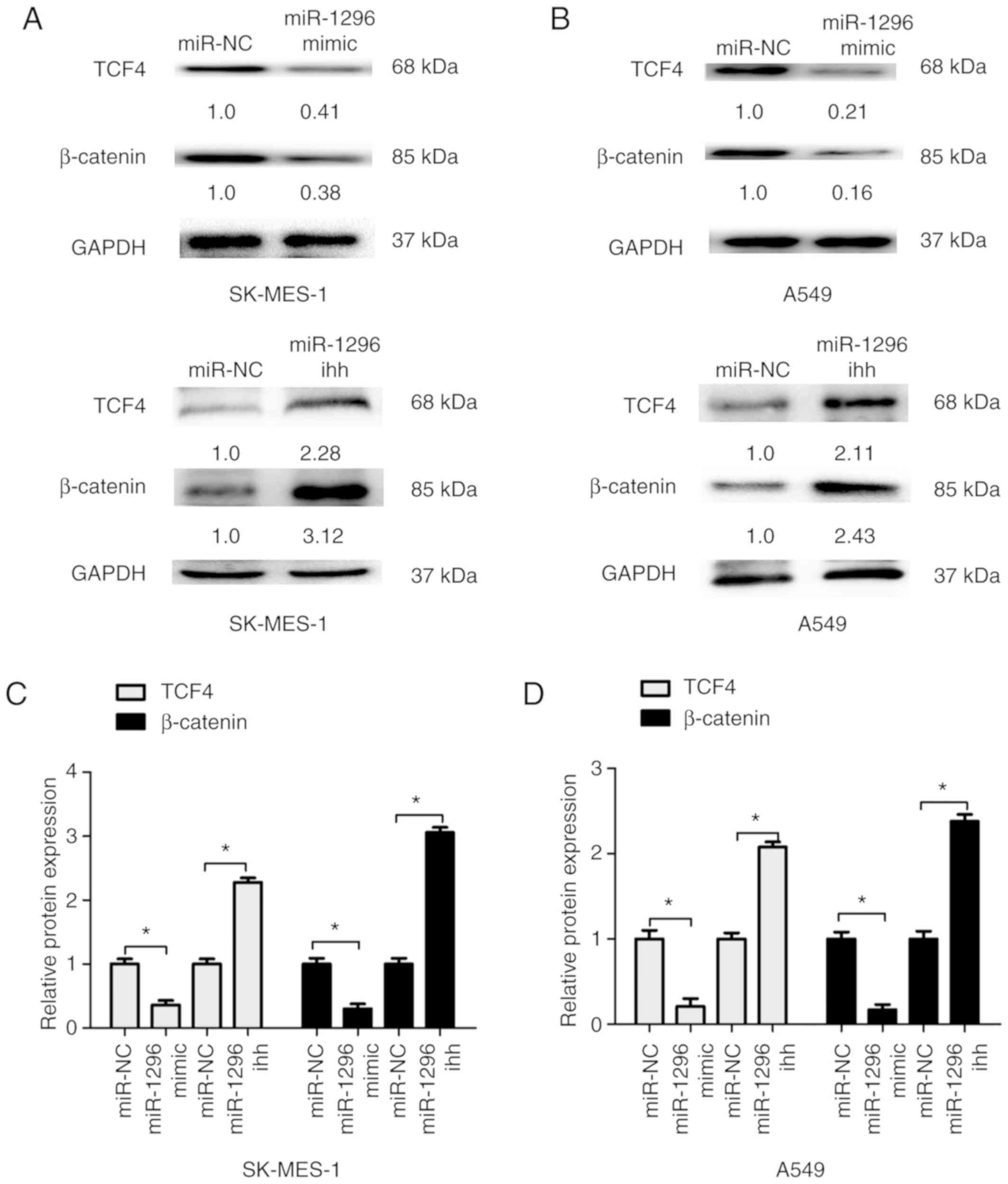MicroRNA‑1296 expression is associated with prognosis and inhibits cell proliferation and invasion by Wnt signaling in non‑small cell lung cancer
- Authors:
- Published online on: November 28, 2019 https://doi.org/10.3892/ol.2019.11154
- Pages: 623-630
-
Copyright: © Deng et al. This is an open access article distributed under the terms of Creative Commons Attribution License.
Abstract
Introduction
Lung cancer is one of the most rapidly growing types of cancer and exhibits a high cancer-associated morbidity rate worldwide (1). Non-small cell lung cancer (NSCLC) accounts for ~80% of lung cancer cases (2). Treatment methods, including surgery, radiotherapy, chemotherapy and molecular targeted therapy, have improved the overall survival rate, but prognosis for patients diagnosed at an advanced stage remains poor (3,4). Therefore, it is urgent to investigate novel biomarkers for diagnosis and prediction of prognosis for patients with NSCLC.
MicroRNAs (miRNAs) are a class of small non-coding RNAs involved in post-transcriptional regulation of gene expression through interactions with the 3′ untranslated regions (3′UTRs) of target mRNAs (5,6). In NSCLC, certain miRNAs have been identified as biomarkers or therapeutic targets; for example, high expression levels of miRNA (miR)-18a, miR-20a and miR-92a correlate with poor prognosis in patients with NSCLC (7). High expression of miR-493-5p may improve clinical prognosis of NSCLC by targeting the oncogene integrin subunit b1 (8). miR-410 acts as an oncogene in NSCLC by downregulating solute carrier family 34 member through the activation of the Wnt/β-catenin pathway (9). However, the functional effects and underlying role of miR-1296 in NSCLC remain unknown. Therefore, the present study investigated the function of miR-1296 in NSCLC.
The results of the present study demonstrated that miR-1296 expression was significantly downregulated in NSCLC tissues and cells. In addition, survival analysis revealed that reduced miR-1296 expression was associated with a poor prognosis in patients with NSCLC. Multivariate Cox analysis demonstrated that reduced miR-1296 expression was an independent risk factor of NSCLC prognosis. Overexpression of miR-1296 inhibited cell proliferation, invasion and Wnt signaling in NSCLC. In conclusion, these results indicated that miR-1296 expression may be a potential biomarker of NSCLC prognosis and potential target of NSCLC treatment.
Materials and methods
Patients and tissue samples
NSCLC and adjacent normal tissue samples were collected from 106 NSCLC patients (54 male and 52 female) who underwent surgical resection at the Department of Cardiothoracic Surgery, The Second People's Hospital of Qinzhou (Qinzhou, China) between December 2010 and December 2014. Following surgical resection, the tissue samples were immediately frozen and stored at −80°C until RNA extraction. The age of the patients ranged between 26 and 80 years (mean age, 50.5 years). The experiments were approved by the Ethics Committee of The Second People's Hospital of Qinzhou. Written informed consent was obtained from all patients. Clinical stages were classified according to the World Health Organization Tumor-Node-Metastasis (TNM) criteria (10).
Cell culture and transfection
Four human NSCLC cell lines: A549, H1299, H460 and SK-MES-1, and an immortalized and non-tumorigenic human bronchial epithelial cell line NL20 were purchased from American Type Culture Collection. The cell lines were cultured in RPMI-1640 (Gibco; Thermo Fisher Scientific, Inc.) medium supplemented with 10% FBS (Gibco; Thermo Fisher Scientific, Inc.) at 37°C in 5% CO2. A total of 1×106 cells were transfected with 100 nM miRNA-negative control (miR-NC), miR-1296 mimic (100 nM) or miR-1296 inhibitor (100 nM; Chang Jing Bio-Tech, Ltd.) using Lipofectamine® 3000 reagent (Invitrogen; Thermo Fisher Scientific, Inc.) according to the manufacturer's instructions. The cells were harvested for RT-qPCR or western blot analysis to assess the mRNA and protein expression 48 h following transfection.
RNA extraction and reverse transcription-quantitative PCR (RT-qPCR)
Total RNA was extracted from tissues and cells using TRIzol® reagent (Invitrogen; Thermo Fisher Scientific, Inc.) according to the manufacturer's protocol. The RNA was reverse transcribed to generate cDNA using Prime Script RT-PCR kit (Takara Biotechnology Co., Ltd.) according to the manufacturer's protocol The thermocycling conditions were as follows: 95°C for 5 min, followed by 40 cycles of 95°C for 10 sec and 60°C for 30 sec. U6 small nuclear RNA was used as an internal control. U6 forward, 5′-CTCGCTTCGGCAGCACA-3′, and reverse, 5′-AAACGCTTCACGAATTTGCGT-3′. miR-1296 primers were purchased from Takara Biotechnology Co., Ltd. The mRNA expression fold changes were calculated using the 2−ΔΔCq method (11).
Cell proliferation assay
Cell proliferative ability was evaluated by using Cell Counting Kit-8 (CCK-8; Dojindo Molecular Technologies, Inc.) according to the manufacturer's instructions. Briefly, transfected cells (3×103 cells/well) were seeded in 96-well plates. Following cell were culture for 1, 2, 3 and 4 days, CCK-8 solution was added to each well and then incubated for 2 h at 37°C in a humidified atmosphere with 5% CO2. Cell proliferation was detected by a VICTOR microplate reader (BioTek Instruments, Inc.) and absorbance was measured at 450 nm.
Transwell assay
Transwell cell invasion assay was performed using a 24-well Transwell chamber (Costar; Corning, Inc.) with Matrigel (BD Biosciences). Transfected cells (1×105 cells/well) in serum-free medium were seeded in the upper chamber. Medium with 10% FBS was added to the lower chamber. The cells were maintained at 37°C in a humidified atmosphere with 5% CO2 for 48 h. The cells in the lower chamber were fixed with 100% methanol for 20 min at 4°C, stained using 1% crystal violet for 15 min 4°C and counted using a light microscope (Olympus Corporation).
Western blot analysis
Transfected cells were lysed in radioimmunoprecipitation assay buffer according to the manufacturer's instructions. Protein concentrations were determined using a Nanodrop 2000 spectrophotometer (Thermo Fisher Scientific, Inc) by measuring optical density at a wavelength of 280 nm. Protein (30 µg/lane) was separated by SDS-PAGE on 10% gels and transferred onto polyvinylidene fluoride membrane. The membranes were blocked with 5% skimmed milk at room temperature for 1.5 h and incubated with specific primary antibodies against transcription factor 4 (TCF4; 1:1,000; cat. no. sc-8631, Santa Cruz Biotechnology, Inc., CA, USA), β-catenin (1:500; cat. no. sc-16512, Santa Cruz Biotechnology, Inc., CA, USA) and GAPDH (1:1,000; cat. no. sc-16512 2118S, Cell Signaling Technology, Inc., CA, USA) overnight at 4°C. Primary antibody incubation was followed by incubation with horseradish peroxidase-conjugated secondary antibodies (1:1,000; cat. no. sc-2357; Santa Cruz Biotechnology, Inc.) at room temperature for 1 h. The proteins were detected using an enhanced chemiluminescence (ECL) detection system (Bio-Rad Laboratories, Inc.) and an ECL kit (cat. no. 32106; Thermo Fisher Scientific, Inc.). ImageJ software (version 1.48; National Institutes of Health Bethesda) was used to measure the band density. GAPDH was used as a loading control.
Statistical analysis
The data were analyzed using SPSS 18.0 software (SPSS, Inc.). The results are presented as the mean ± standard deviation. Differences between two groups were analyzed using Student's t-test; differences among ≥3 groups were analyzed using one-way analysis of variance, followed by multiple comparisons by the Student-Newman-Keuls test. The χ2 test was used to evaluate the association between miR-1296 and clinical factors. The Kaplan-Meier method was used to plot the survival curves, and the log-rank test was used for overall survival analysis. P<0.05 was considered to indicate a statistically significant difference.
Results
miR-1296 expression is downregulated in patients with NSCLC and in NSCLC cells
To analyze the role of miR-1296 expression in NSCLC, the expression levels of miR-1296 in NSCLC tissues and adjacent normal tissues were evaluated by RT-qPCR. The results demonstrated that miR-1296 expression levels in NSCLC tissues were significantly lower compared with in adjacent normal tissues (P<0.05; Fig. 1A). In addition, four human NSCLC cell lines exhibited significantly downregulated miR-1296 expression compared with the normal control NL20 cell line (Fig. 1B). Thus, these results indicated that low miR-1296 expression levels may potentially serve as a prognostic marker for patients with NSCLC.
Downregulation of miR-1296 expression is associated with TNM stage and lymph-node metastasis of patients with NSCLC
Patient with NSCLC were classified into two groups by miR-1296 expression (high and low) based on the median expression of miR-1296 in all NSCLC tissue samples. Clinicopathological characteristic analysis demonstrated that low miR-1296 expression was closely associated with lymph-node metastasis (P=0.001; Table I) and advanced TNM stage (P=0.006; Table I). By contrast, no association was observed between miR-1296 expression and other clinicopathological features, including sex, age, tumor differentiation and tumor size (Table I).
Table I.Association between clinicopathological characteristics of 106 patients and miR-1296 expression levels in non-small cell lung cancer. |
Association of miR-1296 expression and prognosis of patients with NSCLC
The Kaplan-Meier method was used to plot the survival curves, which were further analyzed by the log-rank test. The results demonstrated that low miR-1296 expression was associated with poor disease-free survival (DFS; P<0.05; Fig. 2A) and overall survival (OS; P<0.05; Fig. 2B) of patients with NSCLC compared with high miR-1296 expression. Univariate and multivariate Cox proportional hazards regression model analysis revealed that lymph node metastasis [P=0.001; hazard ratio (HR)=2.038; 95% confidence interval (CI), 0.712–3.664], advanced TNM stage (P=0.001; HR=2.113; 95% CI, 0.812–3.544) and low miR-1296 expression (P=0.001; HR=2.263; 95% CI, 1.125–3.732) were independent predictors of poor DFS in NSCLC (Table II). In addition, lymph node metastasis (P=0.001; HR=1.932; 95% CI, 0.872–3.145), advanced TNM stage (P=0.001; HR=2.063; 95% CI, 0.995–3.448) and low miR-1296 expression (P=0.001; HR=2.138; 95% CI, 1.042–4.349) were independent predictors of poor overall survival rate in NSCLC (Table III). These results suggested that low miR-1296 expression may be an independent predictor for poor prognosis in patients with NSCLC.
Table II.Univariate and multivariate Cox analysis of disease-free survival in 106 patients with non-small cell lung cancer. |
Table III.Univariate and multivariate Cox analysis of overall survival in 106 patients with non-small cell lung cancer. |
miR-1296 suppresses cell proliferation and invasion in NSCLC cells
To further investigate the effects of miR-1296 expression in NSCLC cells, CCK-8 cell proliferation and Transwell assays were performed. SK-MES-1 and A549 cells were transfected with a miR-1296 mimic or miR-1296 inhibitor for upregulation or downregulation of miR-1296 expression levels, as they exhibited higher or lower expression of miR-1296 compared with the other two cell lines (Fig. 3A and B). The results of the CCK-8 assay indicated that miR-1296 overexpression in SK-MES-1 and A549 cells inhibited cell proliferation, whereas reduced miR-1296 expression enhanced cell proliferation compared with respective negative control groups (Fig. 3C and D). Additionally, Transwell cell invasion assay demonstrated that miR-1296 overexpression in SK-MES-1 and A549 cells inhibited cell invasive ability, whereas reduced miR-1296 expression enhanced cell invasive ability compared with respective negative control groups (Fig. 4). Thus, these results indicated that miR-1296 may suppress cell proliferation and invasion of NSCLC cells.
miR-1296 suppresses Wnt signaling in NSCLC cells
To investigate the effects of miR-1296 expression in the Wnt signaling pathway, western blot analysis of downstream factors β-catenin and TCF4 was performed. The results indicated that miR-1296 overexpression inhibited Wnt signaling pathway by reducing β-catenin and TCF4 expression in SK-MES-1 and A549 cells compared with respective control groups. By contrast, downregulation of miR-1296 significantly increased β-catenin and TCF4 protein expression levels in SK-MES-1 and A549 cells compared with the control groups (Fig. 5). These results indicated that miR-1296 may suppress Wnt signaling in NSCLC cells.
Discussion
Abnormal gene expression in cancer involves inactivation of tumor suppressor genes and activation of oncogenes (12). miRNAs are key regulators of tumor progression in NSCLC, and certain miRNAs are valuable for diagnostics and treatment of NSCLC (13). A previous study revealed that dysregulation of miRNA expression may be used as sensitive and accurate biomarkers or prognostic predictors of human NSCLC (14). For example, miR-137 is downregulated and its promoter is hypomethylated in lung cancer, and high levels of miR-137 promoter methylation are associated with poor disease-free survival in NSCLC (15); plasma exosomal microRNA-451a is a noninvasive biomarker for early prediction of recurrence and prognosis in non-small cell lung cancer (NSCLC) patients after curative resection (16). Serum miR-494 was significantly elevated in NSCLC patients and closely correlated with poor clinical outcome (17).
miR-1296 has been identified as a tumor suppressor in several types of cancer; for example, miR-1296-5p may be involved in the regulation of migration and invasion of human gastric cancer cells at least in part by targeting the erb-b2 receptor tyrosine kinase 2 (ERBB2)/Rac family small GTPase 1 signaling pathway (18). miR-1296-5p is involved in the regulation of proliferation of breast cancer cells by targeting the ERBB2/MTOR complex 1 signaling pathway (19). Downregulation of miR-1296 may serve as a prognostic biomarker in hepatocellular carcinoma (HCC) and miR-1296 inhibits metastasis and epithelial-mesenchymal transition in HCC by targeting the SRSF protein kinase 1-mediated PI3K/AKT pathway (20). In the present study, miR-1296 expression was significantly downregulated in NSCLC tissues compared to adjacent normal tissues. In addition, miR-1296 expression was downregulated in NSCLC cell lines compared with a normal lung cell line. Survival analysis demonstrated that low miR-1296 expression predicted poor prognosis. Additionally, multivariate Cox analysis revealed that low miR-1296 expression was an independent risk factor of NSCLC prognosis. Thus, these results indicated that miR-1296 expression level may be a potential biomarker for NSCLC prognosis.
The present study demonstrated that miR-1296 overexpression inhibits cell proliferation and invasion, whereas reduced miR-1296 expression enhanced cell proliferation and invasion compared with the control groups. Wnt signaling pathway is involved in tumor cell proliferation and invasion in NSCLC (21); in the present study, miR-1296 overexpression inhibited Wnt signaling by reducing the expression levels of two key proteins, β-catenin and TCF4, in NSCLC cells. By contrast, downregulation of miR-1296 significantly promoted Wnt signaling by increasing β-catenin and TCF4 expression in NSCLC cells.
In conclusion, the present study demonstrated that miR-1296 expression was reduced in NSCLC tissues and cell lines compared with healthy tissues and cells. In addition, low miR-1296 expression was associated with advanced TNM stage and lymph-node metastasis of patients with NSCLC. miR-1296 expression level was identified as a prognostic predictor of NSCLC. Overexpression of miR-1296 inhibited cell proliferation, invasion and Wnt signaling in NSCLC. These results indicated that miR-1296 expression may be a potential biomarker for NSCLC prognosis, as well as a potential target of NSCLC treatment.
Acknowledgements
Not applicable.
Funding
No funding was received.
Availability of data and materials
The datasets used and/or analyzed during the present study are available from the corresponding author on reasonable request.
Authors' contributions
HD, YY and ZD conceived and designed the study, and drafted the manuscript. HD, YY, CX and ZD collected, analyzed and interpreted the data and critically revised the manuscript. All authors have read and approved the final manuscript.
Ethics approval and consent to participate
The study was approved by the Ethics Committee of Second People's Hospital of Qinzhou (Qinzhou, China). Written informed consent was obtained from all patients in the study.
Patient consent for publication
Not applicable.
Competing interests
The authors declare that they have no competing interests.
References
|
Molina JR, Yang P, Cassivi SD, Schild SE and Adjei AA: Non-small cell lung cancer: Epidemiology, risk factors, treatment, and survivorship. Mayo Clin Proc. 83:584–594. 2008. View Article : Google Scholar : PubMed/NCBI | |
|
Carney DN and Hansen HH: Non-small-cell lung cancer-stalemate or progress? N Engl J Med. 343:1261–1262. 2000. View Article : Google Scholar : PubMed/NCBI | |
|
Sánchez de Cos J, Sojo González MA, Montero MV, Pérez Calvo MC, Vicente MJ and Valle MH: Non-small cell lung cancer and silent brain metastasis. Survival and prognostic factors. Lung Cancer. 63:140–145. 2009. View Article : Google Scholar : PubMed/NCBI | |
|
Suresh R, Ali S, Ahmad A, Philip PA and Sarkar FH: The role of cancer stem cells in recurrent and drug-resistant lung cancer. Adv Exp Med Biol. 890:57–74. 2016. View Article : Google Scholar : PubMed/NCBI | |
|
Hwang HW and Mendell JT: MicroRNAs in cell proliferation, cell death, and tumorigenesis. Br J Cancer. 96 (Suppl):R40–R44. 2007.PubMed/NCBI | |
|
Bartel DP: MicroRNAs: Genomics, biogenesis, mechanism, and function. Cell. 116:281–297. 2004. View Article : Google Scholar : PubMed/NCBI | |
|
Xu X, Zhu S, Tao Z and Ye S: High circulating miR-18a, miR-20a, and miR-92a expression correlates with poor prognosis in patients with non-small cell lung cancer. Cancer Med. 7:21–31. 2018. View Article : Google Scholar : PubMed/NCBI | |
|
Liang Z, Kong R, He Z, Lin LY, Qin SS, Chen CY, Xie ZQ, Yu F, Sun GQ, Li CG, et al: High expression of miR-493-5p positively correlates with clinical prognosis of non small cell lung cancer by targeting oncogene ITGB1. Oncotarget. 8:47389–47399. 2017.PubMed/NCBI | |
|
Zhang X, Ke X, Pu Q, Yuan Y, Yang W, Luo X, Jiang Q, Hu X, Gong Y, Tang K, et al: MicroRNA-410 acts as oncogene in NSCLC through downregulating SLC34A2 via activating Wnt/β-catenin pathway. Oncotarget. 7:14569–14585. 2016.PubMed/NCBI | |
|
Okuyemi OT, Piccirillo JF and Spitznagel E: TNM staging compared with a new clinicopathological model in predicting oral tongue squamous cell carcinoma survival. Head Neck. 36:1481–1489. 2014.PubMed/NCBI | |
|
Livak KJ and Schmittgen TD: Analysis of relative gene expression data using real-time quantitative PCR and the 2(-Delta Delta C(T)) method. Methods. 25:402–408. 2001. View Article : Google Scholar : PubMed/NCBI | |
|
Zhang B, Pan X, Cobb GP and Anderson TA: microRNAs as oncogenes and tumor suppressors. Dev Biol. 302:1–12. 2007. View Article : Google Scholar : PubMed/NCBI | |
|
Skrzypski M, Dziadziuszko R and Jassem J: MicroRNA in lung cancer diagnostics and treatment. Mutat Res. 717:25–31. 2011. View Article : Google Scholar : PubMed/NCBI | |
|
Gu Y, Cheng Y, Song Y, Zhang Z, Deng M, Wang C, Zheng G and He Z: MicroRNA-493 suppresses tumor growth, invasion and metastasis of lung cancer by regulating E2F1. PLoS One. 9:e1026022014. View Article : Google Scholar : PubMed/NCBI | |
|
Min L, Wang F, Hu S, Chen Y, Yang J, Liang S and Xu X: Aberrant microRNA-137 promoter methylation is associated with lymph node metastasis and poor clinical outcomes in non-small cell lung cancer. Oncol Lett. 15:7744–7750. 2018.PubMed/NCBI | |
|
Kanaoka R, Iinuma H, Dejima H, Sakai T, Uehara H, Matsutani N and Kawamura M: Usefulness of plasma exosomal MicroRNA-451a as a noninvasive biomarker for early prediction of recurrence and prognosis of non-small cell lung cancer. Oncology. 94:311–323. 2018. View Article : Google Scholar : PubMed/NCBI | |
|
Zhang J, Wang T, Zhang Y, Wang H, Wu Y, Liu K and Pei C: Upregulation of serum miR-494 predicts poor prognosis in non-small cell lung cancer patients. Cancer Biomark. 21:763–768. 2018. View Article : Google Scholar : PubMed/NCBI | |
|
Shan X, Wen W, Zhu D, Yan T, Cheng W, Huang Z, Zhang L, Zhang H, Wang T, Zhu W, et al: miR 1296-5p inhibits the migration and invasion of gastric cancer cells by repressing ERBB2 expression. PLoS One. 12:e01702982017. View Article : Google Scholar : PubMed/NCBI | |
|
Chen G, He M, Yin Y, Yan T, Cheng W, Huang Z, Zhang L, Zhang H, Liu P, Zhu W and Zhu Y: miR-1296-5p decreases ERBB2 expression to inhibit the cell proliferation in ERBB2-positive breast cancer. Cancer Cell Int. 17:952017. View Article : Google Scholar : PubMed/NCBI | |
|
Xu Q, Liu X, Liu Z, Zhou Z, Wang Y, Tu J, Li L, Bao H, Yang L and Tu K: MicroRNA-1296 inhibits metastasis and epithelial-mesenchymal transition of hepatocellular carcinoma by targeting SRPK1-mediated PI3K/AKT pathway. Mol Cancer. 16:1032017. View Article : Google Scholar : PubMed/NCBI | |
|
Stewart DJ: Wnt signaling pathway in non-small cell lung cancer. J Natl Cancer Inst. 106:djt3562014. View Article : Google Scholar : PubMed/NCBI |



